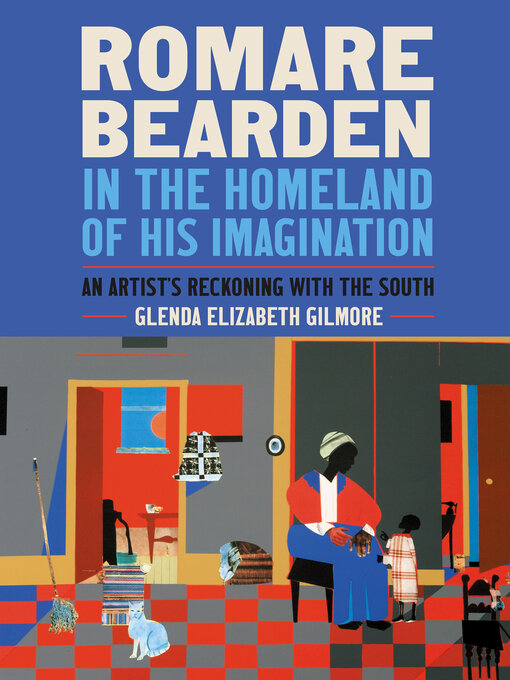Romare Bearden in the Homeland of His Imagination
An Artist's Reckoning with the South
Gilmore explores four generations of Bearden's family and highlights his experiences in North Carolina, Pittsburgh, and Harlem. She engages deeply with Bearden's art and considers it as an alternative archive that offers a unique perspective on the history, memory, and collective imagination of Black southerners who migrated to the North. In doing so, she revises and deepens our appreciation of Bearden's place in the artistic canon and our understanding of his relationship to southern, African American, and American cultural and social history.
-
Creators
-
Series
-
Publisher
-
Release date
March 10, 2022 -
Formats
-
Kindle Book
-
OverDrive Read
- ISBN: 9781469667874
-
EPUB ebook
- ISBN: 9781469667874
- File size: 21403 KB
-
-
Languages
- English
-
Reviews
-
Kirkus
March 15, 2022
A reassessment of one of America's greatest 20th-century artists and his role in defining Black experience. In this incisive study of Romare Bearden (1911-1988), Gilmore, a professor of history emerita at Yale, pays close attention to both the significance of the artist's connections to his extended family and the influence of his extensive formal training. Part of the Great Migration, Bearden's parents fled the dangers and injustices of Jim Crow with their young son, relocating from North Carolina to New York City. The status of Blacks in the South became a lasting theme for Bearden, who continually returned to his childhood memories as he sought a representative vision of Black life in America. Gilmore frames much of Bearden's oeuvre in relation to those memories, which sometimes deviate from the historical record and often suggest the construction of a mythic past. "As he created paintings and collages," writes the author, "he often did not know what was real, what was partially real, and what was a dream. This creative conundrum drove his artistic expression and sparked his imagination." In tracing the arc of Bearden's artistic development, Gilmore emphasizes the importance of his training at schools such as New York University and the Sorbonne and his immersion in a range of styles and movements. He experimented with cubism, Dadaism, surrealism, social realism, abstract expressionism, and, from the late 1950s onward, in what became his most celebrated mode, collage. Gilmore revealingly sets individual works in the context of Bearden's own recollections, his engagement with and deviations from particular conventions, and the broader cultural milieu in which he lived. A late work such as Family (1986), for instance, is understood in relation to the family photograph (and the complex interpersonal dynamics) that inspired it, along with techniques associated with artists such as Matisse and C�zanne that Bearden creatively adapted. A thoughtful, illuminating investigation of Bearden's place in--and shaping of--20th-century American art.COPYRIGHT(2022) Kirkus Reviews, ALL RIGHTS RESERVED.
-
Library Journal
April 1, 2022
"I never left Charlotte [NC], except physically," Black artist Romare Bearden (1911-88) says in Gilmore's (emerita, history, Yale Univ.) adept reappraisal of Bearden's life and art. Bearden was a child in 1915 when his family fled racially charged Charlotte in the Jim Crow South for Harlem and Pittsburgh, after his Black father was falsely accused of kidnapping light-skinned Romare outside a store. Gilmore thoroughly researches Bearden's family history (his great-grandparents were enslaved by Woodrow Wilson's father, while his mother became a civic leader in Harlem). Gilmore also surveys the stages of his artistic career: from editorial cartooning, to social realist painting as a member of the Harlem Artists Guild in the 1930s and 1940s, to works influenced by Abstract Expressionism in the 1950s. But it was Bearden's cut-paper collages celebrating the Black American experience--often culled from his scant memories of rural life in the South and urban life in the North (most notably, The Block)--that shot him to fame. Gilmore also addresses Bearden's social activism and life as a Black artist working in the 20th century. VERDICT Like Bearden's art, Gilmore's biography pulses with energy and will resonate with readers of Isabel Wilkerson's The Warmth of Other Suns: The Epic Story of America's Great Migration.--Denise Miller
Copyright 2022 Library Journal, LLC Used with permission.
-
Formats
- Kindle Book
- OverDrive Read
- EPUB ebook
subjects
Languages
- English
Loading
Why is availability limited?
×Availability can change throughout the month based on the library's budget. You can still place a hold on the title, and your hold will be automatically filled as soon as the title is available again.
The Kindle Book format for this title is not supported on:
×Read-along ebook
×The OverDrive Read format of this ebook has professional narration that plays while you read in your browser. Learn more here.


